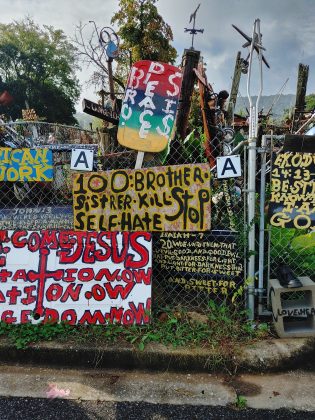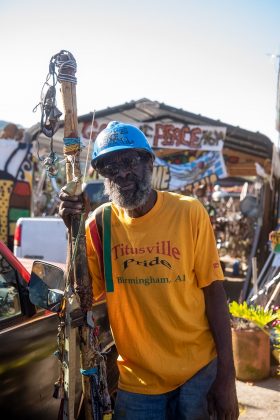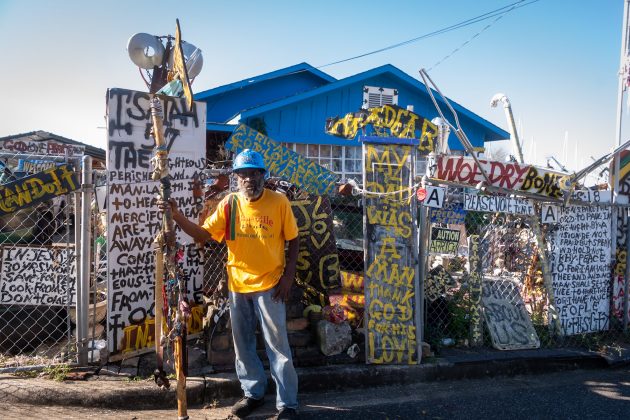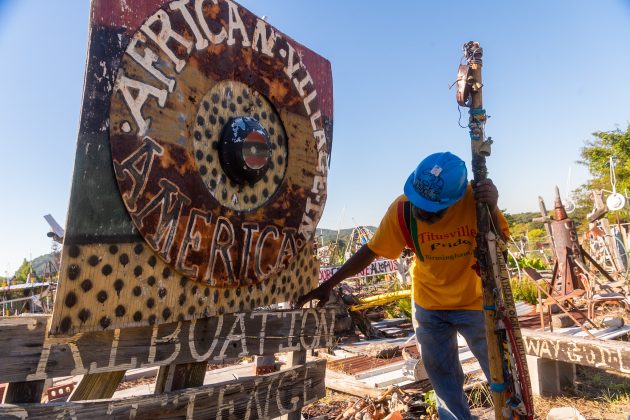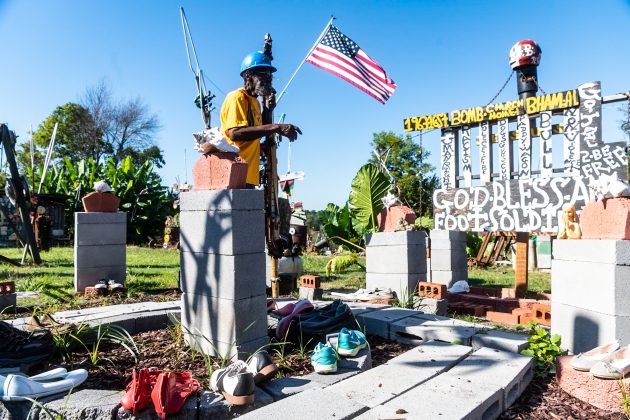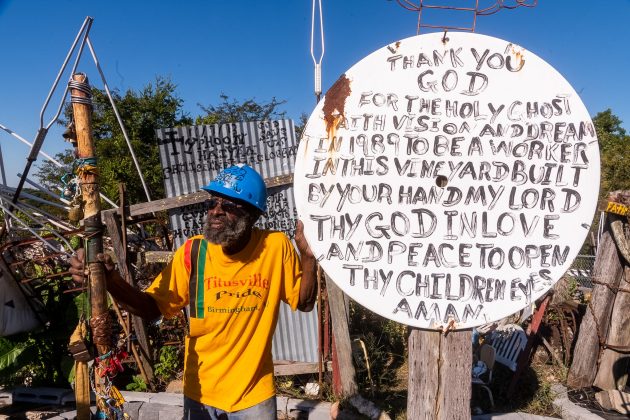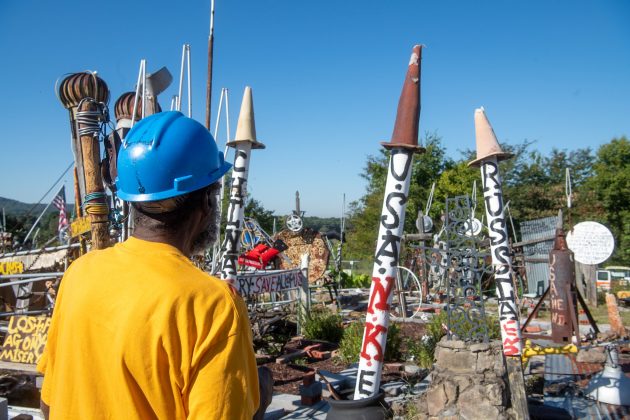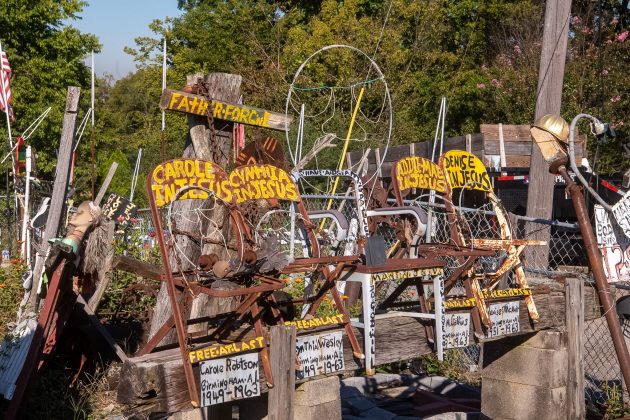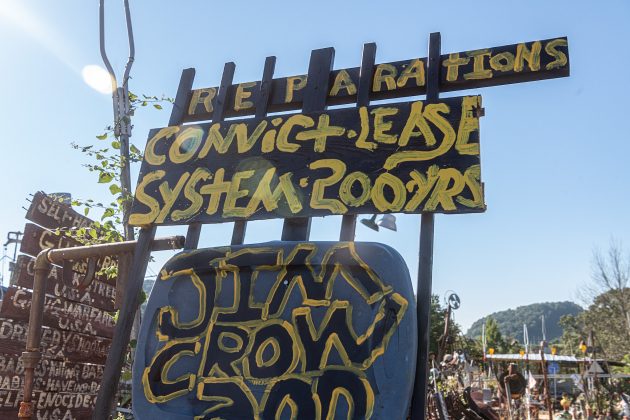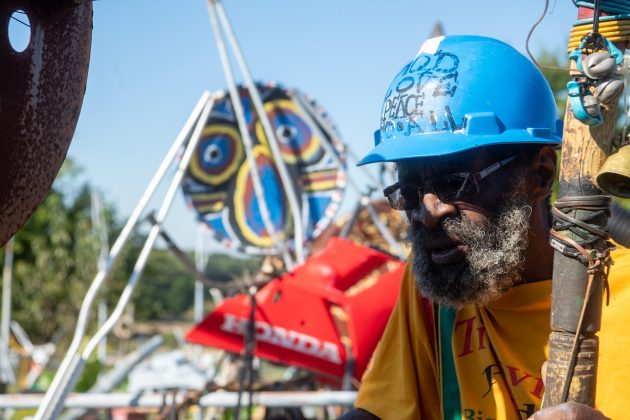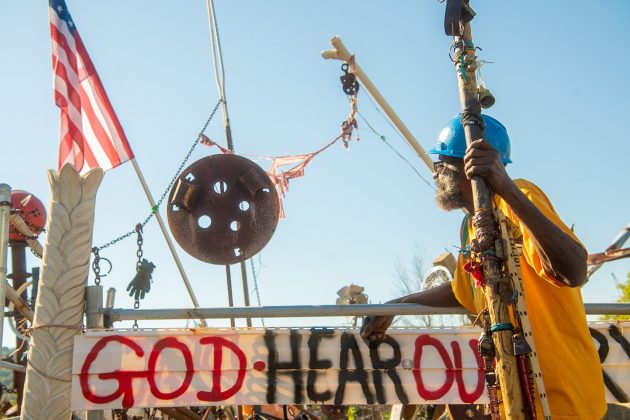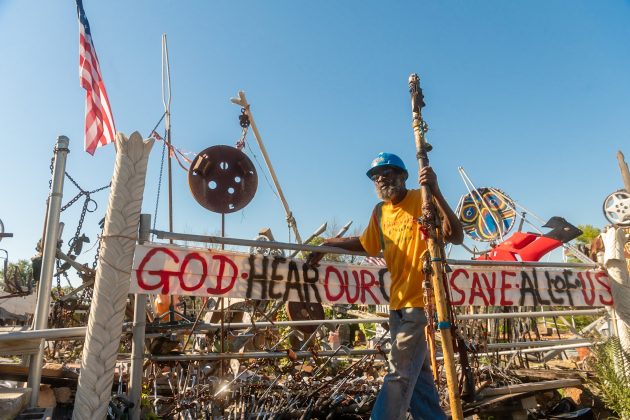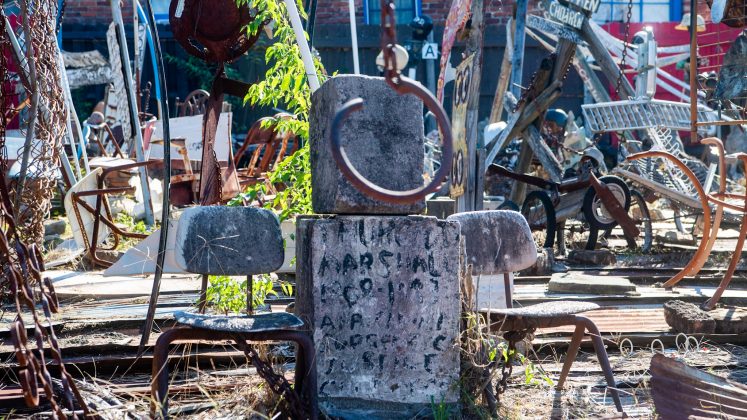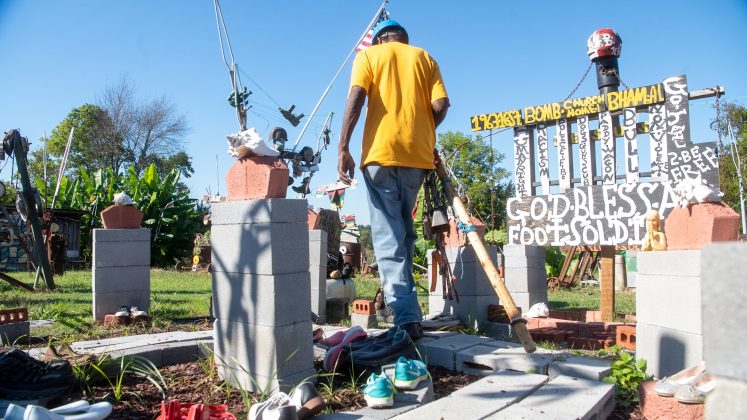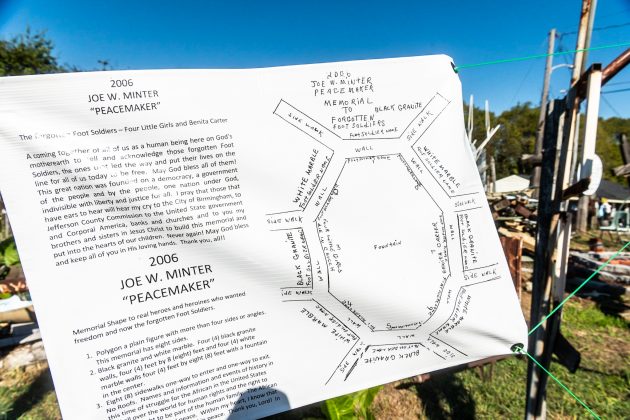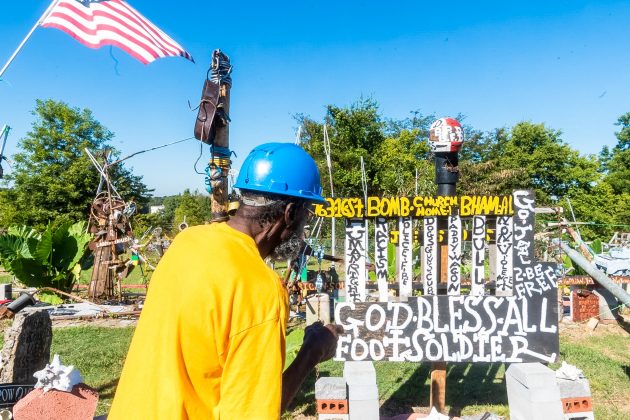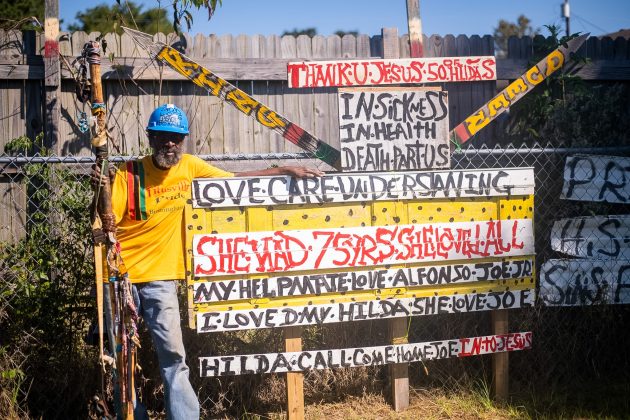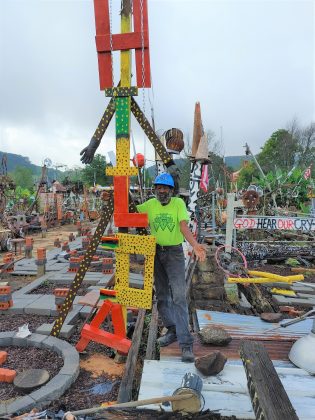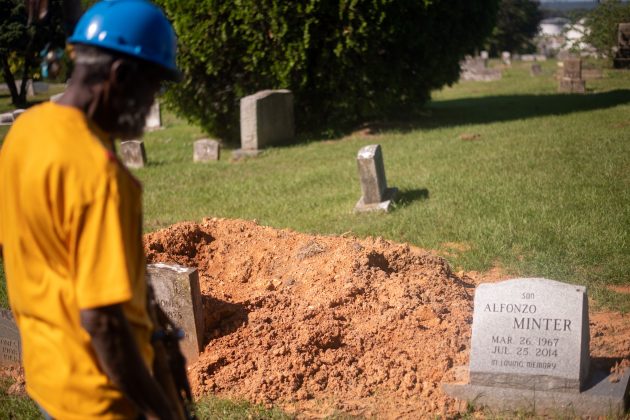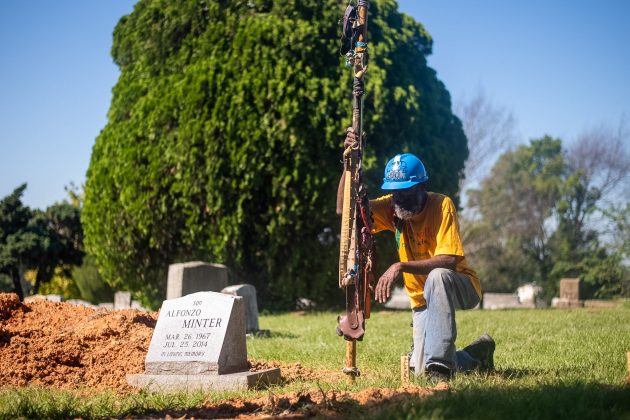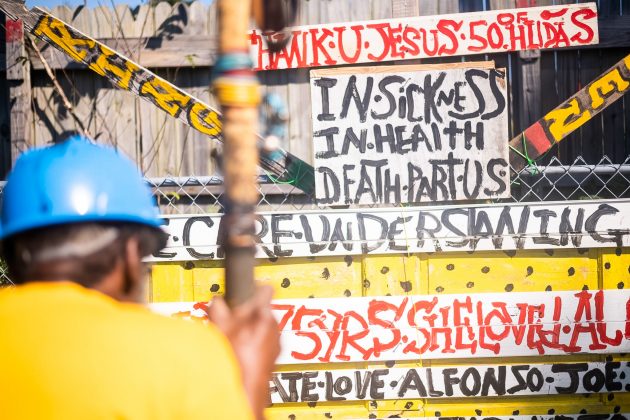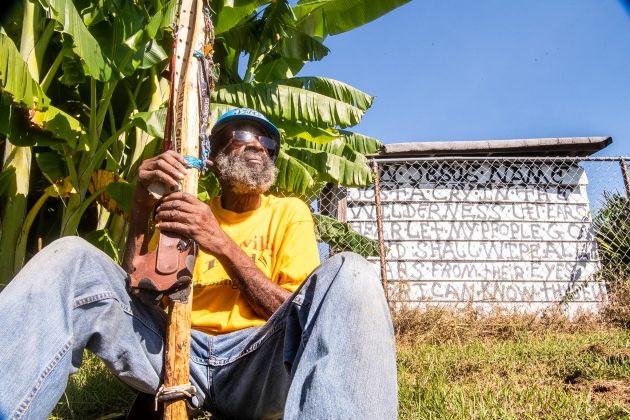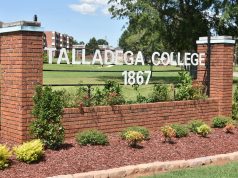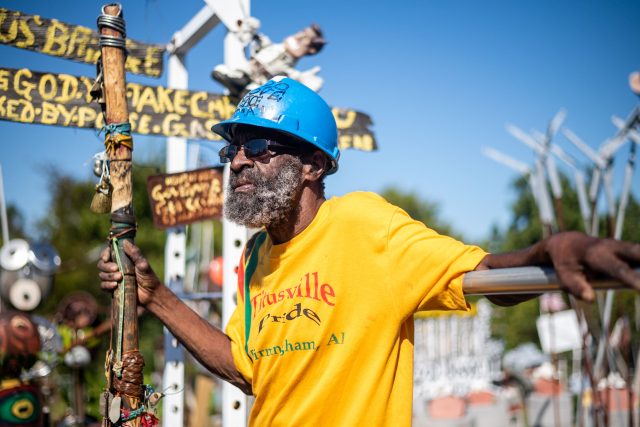
By Ryan Michaels
The Birmingham Times
Joe Minter stands with one boot on a cinder block path, one on grass.
His eyeglasses, the kind that go dark in the sun, sit halfway down his nose and let his tensed eyes peek out. His walking stick, taller than he, holds countless trinkets. Among them are a Casio digital watch, a Spongebob Squarepants keychain, and a belt that has “GIRL ATHLETIC” printed three times along its length.
Most crucially, Minter stands tall in his half-acre yard wearing one of his signature construction hard hats. He has named that yard, on his Woodland Park property, the “African Village in America,” which is home to a collection of sculptures and other art that reflect the story of African struggle in America.
While the site itself features numerous found-object creations, visitors soon learn that Minter has a purpose for every item he collects, including his head coverings.
“To protect God’s temple. That’s what all of it comes from,” Minter said, explaining the hard hat’s purpose. “The temple is what controls the electronic part of what you are. Your heart beats at a rhythm that everybody’s heart beats in, and what the beat is really a drum, and the drum is the main conductor of everything—it comes from the field and the vibrations that come through you when your heart beats.”
Minter, 78, is a sculptor and longtime resident of Woodland Park, a neighborhood within Birmingham’s North Titusville community. He was recently featured in a New York Times article, “Saving the Artwork of the South: Deep Investment, and a Drone,” and his sculptures have been showcased across the United States in places like the Whitney Museum of Art and the Metropolitan Museum of Art in New York City, as well as the Smithsonian American Art Museum in Washington, D.C. Currently, the Birmingham Museum of Art has one piece from Minter currently on display: “’63 Foot Soldiers.”
This summer, the University of Alabama used advanced geographic technology to document every square foot of the African Village, a project that will enable viewers to experience the installation in virtual reality. Meanwhile, thousands of visitors from around the world have visited Minter’s yard collection and signed a guest book that he keeps memorialize their trips.
“Use What You Got”
The Birmingham Times recently visited Minter at his home of 50 years, a house that his wife, Hilda Jo Minter, “never liked,” the artist said. She died in September, after living with kidney failure for many years, and is buried about 20 feet behind the house.
“She was a friend. She was a queen. She was, above all of that, an angel,” said Minter, leaning on Hilda’s headstone during our visit.
Minter even has a plot for himself next to his wife, to whom he was married for a half-century.
“She worked with me as far as she could go,” he said. “She had love and pain at the same time. … Everybody was drawn to her.”
Also near his wife’s grave are the burial sites of his son, Alfonzo, who was stabbed to death in 2014 while serving a life sentence at the William E. Donaldson Correctional Facility in Bessemer, Alabama, and his father, Lawrence Dunbar Minter, who died in 1959.
The graves are on land adjacent to his home and Woodland Park’s Shadow Lawn Memorial Gardens, which Minter describes as “one of biggest Black cemeteries in the South, [one that] ought to be set up as a national shrine.”
Minter’s property houses the “African Village in America,” which he started growing in 1989. His yard is a space for a variety of sculptures that often deal with racism and display reverence for African ancestors and spirituality, and he is the collector and architect of the layout for thousands of works of art spread across the property—an effort he embarked on with little money.
“I did the best I could do with that GI Bill money,” said Minter, who was drafted into the military and served from 1965 to 1967. “You see all this, I done did all this bricklaying and everything, everything you see.”
Over three decades, Minter has steadily built his sculpture garden with items he’s found at flea markets, Salvation Army Thrift Stores, or just along the roadways.
“I’m a Chevrolet man,” he said of his automobile preference. “I’ve owned two or three Chevrolet trucks, and I had to keep them trucks going. … [I’d] pick up whatever I had enough money to get because me and my wife was on a set income. … We really ain’t never made no money, but this is called the theory of ‘Use What You Got.’”
Sculptures in the Village are composed of various materials, including iron, wood, and tons of found objects that Minter has usually modified in some way, such as crutches he crafted into spears: “I could get that crutch for two or three dollars for a pair,” he said.
During a series of tours conducted over a two-week period for The Birmingham Times, Minter pointed out that each piece on the property has some sort of meaning. Spears, for example, are a recurring theme in the “African Village in America,” because they represent “the power and the soul of what you would call that part of what a man which is to protect and to provide,” Minter said.
Then there are chains.
“I use chains in my artwork to signal [that this is a country] where Africans came in chains,” he said. “I found out it was two blacksmiths in my family, so I seem to be attached to iron. … I use iron to represent bondage and part of chains that had never been broken. … We’re still using chains on those who haven’t done anything to anybody.”
Minter began constructing the African Village after time of prayer and reflection.
“I asked God for a vision, so this is a vision of God and not only a vision of God. It’s what a man got in his soul, and [I] used that power of that third spirit, which is that power of the Holy Spirit, so this is just what I could put my hands on,” he said. “I could have built something as big as [a mountain], but God filtered to me what I could handle.”
“Mech and Tech”
Joe Wade Minter Sr. was born in Birmingham on March 28, 1943, the eighth of 10 children to Lawrence Dunbar and Rosie McAlpin Minter. His father served in the U.S. Army’s 366th Infantry Regiment, a segregated unit with all Black officers and personnel, during World War I and became a caretaker for Birmingham’s Elmwood Cemetery after being discharged. Minter attended Birmingham’s Washington Elementary School, Center Street Middle School, and Ullman High School.
After graduating from high school, he worked a variety of jobs before beginning a life of sculpting and collecting artwork. He washed dishes at a drive-in restaurant in Birmingham and eventually became a messenger at University Hospital, which later became the University of Alabama at Birmingham (UAB) Hospital. In 1965, Minter was drafted into the U.S. Army, where he attended a “mech and tech” school, which prepares servicemembers for mechanical and engineering careers, in Virginia and became a specialist in operating generators.
Following his discharge from the military in 1967, Minter held positions involving construction, disassembling and reassembling trucks, and, perhaps most importantly, building things out of metal—like school furniture, exercise equipment, and truck beds. Unfortunately, he was forced to resign after 11 years because asbestos dust was hurting his eyes and eventually led to him developing glaucoma.
Minter recalled building toys, or rather putting stuff together that could be “used as a toy.”
Those building skills came in handy when it came time to erecting the “African Village in America.” That talent and something else, Minter said: “The power of the Holy Spirit, so this is just what I could put my hands on.”
Christianity
Christianity is a pervasive theme of Minter’s work, as well. One piece that serves as a sort of introduction upon walking into the “African Village in America” features the line “In the beginning God” before laying out a simple history of the site.
During the tour of his property, Minter also talked about the “heart-to-heart” nature of his work.
“Heart-to-heart means I can open up to you and the three best things, [the] formula for us to use now—the Lord’s Prayer, the 23rd Psalm, and, lastly, the Golden Rule: ‘Do unto others as you would have them do unto you.’”
There is always a sense of optimism to Minter and his work.
“We are a beautiful race that cannot be ignored,” he told William Arnett, the late art collector and founder of the arts nonprofit Souls Grown Deep. “We have gone through tribulation, but from that experience we learn patience and develop the strength of hope. When you take all the fruit off a tree, and there’s one piece left, it is the sweetest piece because it has been through the most to survive. If God choose to bring us along last, we will come last. Something has to come last, to be the best.”
Historian
Minter is as much a historian as he is an artist, and a tour of his property shows it. Having lived through the Civil Rights struggle in Birmingham during the 1960s, Minter has works that reference the first Selma-to-Montgomery march in 1965, during which Alabama state troopers attacked voting rights activists on the Edmund Pettus Bridge. Though a group of police officers brutalized the protestors upon their crossing the bridge, there was still peace amid the violence, Minter said.
“This was a scene of chaos and a scene of serenity. … It was a lot of tears and a lot of hope left on the bridge here,” he said. “The whole world saw it, and the world said, ‘We gon’ do something!’”
That first march, which took place on Feb. 16, 1965, is referred to as “Bloody Sunday.” The events of that day and two following marches led to the passage of the Voting Rights Act of 1965, which prohibited racial discrimination in voting.
Minter also has a sculpture and art that pay homage to the four girls killed during the Sixteenth Street Baptist Church bombing on Sept. 15, 1963, including four empty chairs on his property in honor of the girls.
Minter was in the vicinity of church when the bomb exploded. “I was across the street at a café called Jabbo’s. They used to sell them big old bologna sandwiches, and you’d usually hang out down there because you would get such a big sandwich. I was there when the bomb went off. … I saw the undertakers go in there, and they couldn’t take it,” he said, describing the reactions of first responders to the loss of life caused by the explosion.
A lot of Minter’s works also pay homage to African history.
“My African ancestors built America on the sweat of their backs, in their blood, in their life—free slave labor—and the only pay is death,” he told Arnett, of the arts nonprofit Souls Grown Deep. “I saw how the races was drifting further and further apart and how Black people ourselves was drifting apart. And I asked God to help me find a way that I could help bring people together as one, for understanding, even for the littlest child. Because America had started to lose the family, and when the family is lost, that is the end of all of us here as a people.
“And it finally came back to me that the only way was through art, art is the universal thing. Make the art and put a message with it that could heal the wounds everywhere. Communicate to the world a message of God—love and peace for all.”
Minter’s “African Village in America” is located at 931 Nassau Ave. SW, Birmingham, Alabama 35211 facebook.com/joeminterafricanvillage



